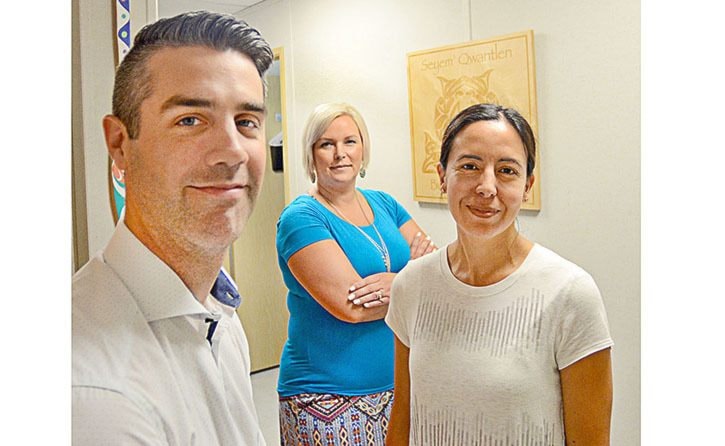This year’s dismal salmon returns in the Fraser River are a stark example of why a community can no longer rely on one industry.
That’s not always easy, particulary for First Nations whose lives are still impacted by the Indian Act, federal legislation that governs everything from health and education to property rights and resources.
A few years ago, Kwantlen First Nation took a big step in taking back some control over its economic future.
The Seyem Qwantlen business group was created in 2011.
“It was created after a lot of council and elders discussion,” said Seyem president Tumia Knott.
Kwantlen First Nation owns the business group which also receives guidance from a community elders group.
“It’s about moving away from having others do it for us,” Knott said.
 KFN has just under 300 members with about 100 living on reserve. The main reserve is about 400 acres. A few people live on reserve lands in Maple Ridge.
KFN has just under 300 members with about 100 living on reserve. The main reserve is about 400 acres. A few people live on reserve lands in Maple Ridge.
Knott said there’s a sizeable youth population. That’s a trend in First Nations across Canada.
“We foresee more members moving back and living on reserve,” she said.
So Seyem is vital to help the community be sustainable, both in the green eco sense and in the green financial sense.
KFN also has reserve lands in Maple Ridge near Albion and Whonnock, and one near the Mission River.
Seyem also serves another key function – providing members with opportunties for skills development and job training in various sectors. It currently has about 100 employees but about 40 per cent are band members. Some are from other First Nations and some are non-native.
Seyem isn’t about excluding others but helping KFN members find their place in the community and society. It’s the difference between make work projects or building careers.
“A lot of opportunties in the past were short term,” she said.
When a contract expired, the person was out of a job.
Knott said Seyem is one way for KFN to work with other First Nations and non-native groups whether that’s with construction firms on housing development or governments on tourism opportunities, for instance.
They didn’t try and reinvent the wheel and looked at various models of operation.
“We spent a lot of time researching and visiting other First Nations communities,” Knott said.
She said they want to control the growth so it doesn’t get away from them and choose business ventures that fit in with the expectations of the community. Seyem Qwantlen isn’t just about making a profit. It must operate within a framework that values environmental stewardship as much as shareholder profit.
 The business group very specifically sought out endeavours in different sectors of the economy, relying on a diversified approach. There’s a security company, a construction/development branch, IT, lelem Arts and Cultural Cafe overlooking Bedford Channel, Šxwimele Gifts (the museum at the Fort Langley National Historic Site), and an 800-hectare woodlot in the Blue Mountains.
The business group very specifically sought out endeavours in different sectors of the economy, relying on a diversified approach. There’s a security company, a construction/development branch, IT, lelem Arts and Cultural Cafe overlooking Bedford Channel, Šxwimele Gifts (the museum at the Fort Langley National Historic Site), and an 800-hectare woodlot in the Blue Mountains.
Not everything has been a slam dunk. The business group worked on a large development in on the north side of the Fraser River.
The area has no services (sewer and water).
 “The costs are high so that’s an obstacle,” she explained.
“The costs are high so that’s an obstacle,” she explained.
The plan was a large commercial development to fund servicing to make the project viable.
Knott said the timing was wrong. They were searching for large anchor tenants at a time when big retailers were shuttering Canadian operations or scaling back.
“We had good interest from smaller retail folks. We needed the big players,” Knott said.
So it’s backburnered while attention is focused on other projects.
One of the most high profile projects in Seyem’s short existance is the Mercedes Benz dealership in Langley City. KFN owns the site of the Dilawri dealdership.
Many of the projects and initiatives are on KFN reserve lands which used to be larger on both sides of the Fraser River.
“The reserve land we have has high economic value,” Knott explained.
That was not overlooked by governments even decades ago.
Back in the 1940s and ’50s the federal government sold sections of Kwantlen reserve lands, in New Westminster (where the B.C. Penetentiary once stood) and in Surrey by the Patullo Bridge with no input from what was then called the Langley Indian Band.
And the main reserve, on McMillan Island in Fort Langley, still bears the impact of government decision makers, namely environmental contamination, such as at the former Albion ferry site and the former Atlantic Waste site.
In November 2015, KFN ratified a land code which gives the community more control over its lands. KFN has also made itself a land management nation, a designation under the Indian Act and Knott said that gave it signficantly more say about the future of the lands.
Seyem is a way for the members to have more of a voice in the economic development that takes place on those lands.
“Before Seyem, all our economic development was handled for us [by the Department of Indian Affairs],” Knott said.
Kwantlen First Nation series:
Sharing the tales, free summer walking tours
Market spotlights native culture
